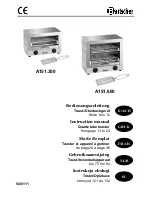
11
3. PROCEDURE
3.1. GENERAL
When it leaves the plant, the device is configured so that it can be used without changing the parameters. For most meas-
urements, simply select the measurement function by turning the switch and press the
TEST
button.
However, you can also parameterize:
the measurements, using the function keys,
or the device itself, using SET-UP.
The device is not designed to operate when the charger is connected. The measurements must be made using battery
power.
3.1.1. CONFIGURATION
When configuring the measurements, you can always choose between:
validating by pressing the
OK
key,
or exiting without saving by pressing the
key.
3.1.2. HELP
In addition to an intuitive interface, the instrument provides complete help in use and analyses and appraisals. Three types of
help function are available:
Help before the measurement can be accessed using the
key. It indicates the connections to be made for each function
and important recommendations.
Error messages appear, as soon as the
TEST
button is pressed, to report connection errors, measurement parameterizing
errors, out-of-range values, defective installations tested, etc.
Help associated with the error messages. Messages containing the
icon invite you to look up the help for ways to
eliminate the error found.
3.1.3. REFERENCE POTENTIAL
The user is assumed to be at the reference earth potential. He/she must therefore not be insulated from earth: must not
wear insulating shoes or insulating gloves and must not use a plastic object to press the
TEST
button.
3.2. VOLTAGE MEASUREMENT
Whichever function is chosen, the device always starts by measuring the voltage present on its terminals.
3.2.1. DESCRIPTION OF THE MEASUREMENT PRINCIPLE
The device separates the alternating voltage from the direct voltage and compares the amplitudes to decide whether the signal
is AC or DC. In the case of an AC signal, the frequency is measured and the device calculates the RMS value of the AC part and
displays it. In the case of a DC signal, the device does not measure its frequency, but calculates its mean value and displays it.
For measurements made at the mains voltage, the device checks that the connection is correct and displays the position of the
phase on the socket outlet. It also checks the presence of a protective conductor on the PE terminal by means of the contact the
user makes with his/her finger by touching the
TEST
button.












































